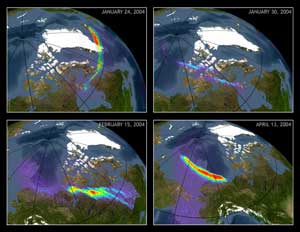Chandra looks back at the Earth

In an unusual observation, a team of scientists has scanned the northern polar region of Earth with NASA’s Chandra X-ray Observatory. The results show that the aurora borealis, or “northern lights,” also dance in X-ray light, creating changing bright arcs of X-ray energy above the Earth’s surface.
While other satellite observations had previously detected high-energy X-rays from the Earth auroras, the latest Chandra observations reveal low-energy X-rays generated for the first time during auroral activity.
The researchers, led by Dr. Ron Elsner of NASA’s Marshall Space Flight Center in Huntsville, Ala., used Chandra to observe the Earth 10 times over a four-month period in 2004. The images were created from approximately 20-minute scans during which Chandra was aimed at a fixed point in the sky and the Earth’s motion carried the auroral regions through Chandra’s field of view.
From the ground, the aurora are known to change dramatically over time, and this is also the case in X-ray light. The X-rays in this sample of the Chandra observations, which have been superimposed on an approximate representation of the Earth, are seen here.
Auroras are produced by solar storms that eject clouds of energetic charged particles. These particles are deflected when they encounter the Earth’s magnetic field, but in the process large electric voltages are created. Electrons trapped in the Earth’s magnetic field are accelerated by these voltages and spiral along the magnetic field into the polar regions. There they collide with atoms high in the atmosphere and emit X-rays. Chandra has also observed dramatic auroral activity on Jupiter.
Dr. Anil Bhardwaj is the lead author on a paper describing these results in the Journal of Atmospheric and Solar-Terrestrial Physics. Dr. Bhardwaj was a co-investigator on this project and worked with Dr. Elsner at NASA’s Marshall Space Flight Center while this research was conducted.
The research team also includes Randy Gladstone, Southwest Research Institute, San Antonio, Texas; Nikolai Østgaard, University of Bergen, Norway; Hunter Waite and Tariq Majeed, University of Michigan, Ann Arbor; Thomas Cravens, University of Kansas, Lawrence; Shen-Wu Chang, University of Alabama, Huntsville; and Albert E. Metzger, Jet Propulsion Laboratory, Pasadena, Calif.
Media Contact
All latest news from the category: Physics and Astronomy
This area deals with the fundamental laws and building blocks of nature and how they interact, the properties and the behavior of matter, and research into space and time and their structures.
innovations-report provides in-depth reports and articles on subjects such as astrophysics, laser technologies, nuclear, quantum, particle and solid-state physics, nanotechnologies, planetary research and findings (Mars, Venus) and developments related to the Hubble Telescope.
Newest articles

“Nanostitches” enable lighter and tougher composite materials
In research that may lead to next-generation airplanes and spacecraft, MIT engineers used carbon nanotubes to prevent cracking in multilayered composites. To save on fuel and reduce aircraft emissions, engineers…

Trash to treasure
Researchers turn metal waste into catalyst for hydrogen. Scientists have found a way to transform metal waste into a highly efficient catalyst to make hydrogen from water, a discovery that…

Real-time detection of infectious disease viruses
… by searching for molecular fingerprinting. A research team consisting of Professor Kyoung-Duck Park and Taeyoung Moon and Huitae Joo, PhD candidates, from the Department of Physics at Pohang University…





















